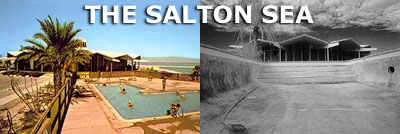 |
 |
 |
|
|||
|
The Jewel Of The
Desert By Ben Adair, 4/5/2002
This whole thing's a mistake. The Salton Sea was supposed to be subdivisions, golf courses, yacht clubs ... the Rat Pack on a catamaran. You know, Palm Springs, only wetter. But it shriveled in the sun. You drive around the sea today and those yacht clubs are abandoned. The motels, boarded and decayed. Along the highway, it's "Available 120 acres, will subdivide." "New three, four bedroom homes! No down payment." At its peak, over a million people vacationed here in a year. Today, RV parks, a hodge-podge of winter residents -- the "snow birds" they call them. The remains of Vacation Paradise Lost. But, what happens when you lose something? Eventually you forget about it, right? And in that space -- that forgetting -- there's a freedom. Away from the watchful eyes of progress, the Salton Sea has gone on -- its own way, at its own pace. Leonard Knight: My name is Leonard Knight, and the hardest part? I'll be real honest. I make a lot of mistakes. And I have to correct them. You can see the Salton Sea from the top of "Salvation Mountain." Salvation Mountain's this crazy mound of fashioned adobe, painted bright pink, red, blue, yellow -- every color latex paint comes in. Salvation Mountain is Leonard Knight's life's work. Salvation Mountain is crooked stairs, caves, a giant fake tree made from mud and discarded railroad ties. One section has an 18-foot pink heart, overlooking a life-sized beach, complete with two-foot adobe white caps. There's even a rowboat. And everywhere you look -- religious slogans. Either, "God is love," or Bible quotes, mostly Acts 2-38. Leonard's the nicest, cutest, most genuine religious enthusiast you'll meet. He spends his days and nights painting the desert. Knight: I was born in Burlington Vermont, and I let my mountain do my talking. Salvation Mountain's on the south shore, close to the Sonny Bono Wildlife Refuge, which is a desert oasis for millions of migrating birds. North of it, on the east shore lies Bombay Beach. Bombay beach is covered in bones, calcified fish heads, fins and scales. The water's a murky blue-brown. Three kids are playing on the levee, above the beach, just a hundred yards from half-buried houses, a half-buried school bus, two half-buried halves of two flooded-out vans. On the water, three birds float and whine. Inland, dogs bark. One of the kids throws a log in -- in the distance, you can barely hear a fish jump. The sun is setting over the Santa Rosa Mountains in the West, turning the sky, sea and desert a crazy pinkish gold. Chris Landis: This little place we're driving up on here -- this small cinder block building was known as Helens Place. And this was a popular spot in the '50s where people would come to recreate here at this beach. Can you make sense of this? There's a photographer named Chris Landis. He has spent a decade trying to. He snaps beautiful Ansel Adams-y black-and-whites of things like decaying swing sets, broken chunks of dock, abandoned, rotting buildings designed by people you've heard of. Most people wanna blame somebody -- bad publicity, the locals say. Chris Landis says the water is filled with fertilizers. Fertilizers make the algae grow -- red algae that turns the water dark brown. In the summer, the algae blooms, sucking up the water's oxygen. One time, over 7 million fish choked to death in one day. Can you picture 7 million fish rotting in the desert? Can you smell it? You wanna swim here? Of course things fell apart. A kind of tragedy, right? The morgue of progress? Landis: I see a lot of beauty in human, man-made things. They're places where people came and had all these hopes and dreams. And I wonder what happened, what caused all the problems. A lot of times we want to protect and preserve the places that have this sort of monumental beauty that appeals to our aesthetic senses. We need to be equally concerned with protecting and preserving and caring for the more humble places, and they need to be protected and watched out for. There is a humility here. But walk among the wreckage of these hopes and dreams -- this paradise created by accident and design. There's a peace too, a connection with a past that hasn't been bulldozed or cordoned off. Things exist here. This isn't a ghost town, it's a monument. Landis: You know the things that we've built, when you build them, we expect them to last forever. They change and they won't be here. You know, you build a hotel in Las Vegas and 15, 20 years later, you blow it up and tear it down. And we've done it quickly here at the Salton Sea. You know, it came and went, and it didn't work out -- and we're not quite sure what's going to happen next. And it's a good place to contemplate what's going to happen next. It is a good place. An important place. Today, it takes about two-and-a-half hours to drive around the Salton Sea -- that's if you don't stop. From your car window, you can admire the scenery -- the Chocolate Mountains, the shimmering sea, the land for sale. But ... stop for a minute. Walk the beach. Trespass on the past. Contemplate the future. I'm
Benjamin Adair, in the Imperial Valley, for The Savvy Traveler.
|
|
Search
Savvy Traveler
|
|
